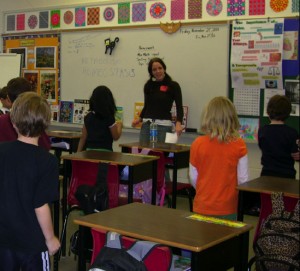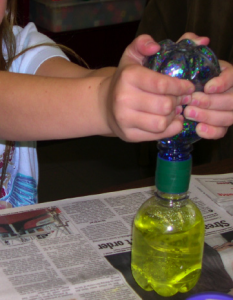Vasopressin
October 10, 2011 in Peptide
Friday, November 24th, 2006, Halifax, NS, 2nd graders grasped their kidneys and learned about vasopressin, thanks to an impressive performance by three MLP students Katie Nizio (BSc SMU), Anna Sprague (MFA Concordia) and Cody Stephenson (MFA NSCAD). Starting out with basic questions about water its importance in the body, particularly in blood, Katie brought us into the kidney where blood is filtered by the nephrons. She explained how Vasopressin, the anti-diuretic peptide, is made by the brain and transferred through the blood to the kidney, where it causes retention of water. Leading a chant on vasopressin and the importance of dinking, retaining and releasing water, Anna had the students dancing about their seats using their favorite archetypical postures for holding water as choreography. Instructing the students in the art of conceptualization, Cody showed how to assemble an hour-glass shaped model of the kidney for each student to bring home. Sequins and water were introduced in a plastic bottle, which was mounted with a filter and second plastic bottle. When this hour-glass was flipped to filter the water from the sequins, all had their first surprise that the water did not move due to surface tension. Then as the students pressed the bottle containing the clear water, they had an even bigger surprise seeing a yellow steam flow into their empty bottle, thanks to a little magic and a touch of food coloring
With seven more peptides to go, we thanked team Vasopressin for retaining pools of MLP interest in 2nd grade in Halifax.
Team Vassopressin, Anna Sprague (MFA Concordia),Cody Stephenson [MFA NSCAD, holding Conceptal Kidney Model (CKM)] and Katie Nizio (BSc SMU)
Anna and all chanting the vasopressin chant and dancing the vasopressin dance.
Conceptual Kidney Model Construction Kit (CKMCK a great gift for the holidays)
Fully assembled CKM being squeezed.
Vasopressin March
by Anna Sprague
When I am driving in the car
(Repeat)
The bathroom seems so very far
(Repeat)
Moma Moma what can I do?
(Repeat)
Vasopressin helping you
(Repeat)
Hold it
1 2
Hold it
3 4
bring it on down
1 2 3 4
3 4
Sweating in the hot hot sun
(Repeat)
Not a drink for anyone
(Repeat)
I don’t have the urge to go
(Repeat)
‘cause vasopressin stops the flow
(Repeat)
Hold it
1 2
Hold it
3 4
bring it on down
1 2 3 4
3 4
Sometimes at night or in the cold
(Repeat)
My bladder is so hard to hold
(Repeat)
When I am bigger I won’t fret
(Repeat)
No longer will my bed get wet
(Repeat)
Hold it
1 2
Hold it
3 4
bring it on down
1 2 3 4
3 4
So,
If your bladder’s really stressin’
(Repeat)
You’re in the clear with vasopressin.
(Repeat)
Stand on one foot, jump up and down
(Repeat)
jog on the spot, then turn around
(Repeat)
Hold it
1 2
Hold it
3 4
bring it on down
1 2 3 4
3 4
Now you know just what to do
(Repeat)
When your body’s telling you
(Repeat)
to try and really hold your pee
(Repeat)
Just sit down and cross your knees.
(Repeat)
Hold it
1 2
Hold it
3 4
Bring it on down
1 2 3 4
3 4
















